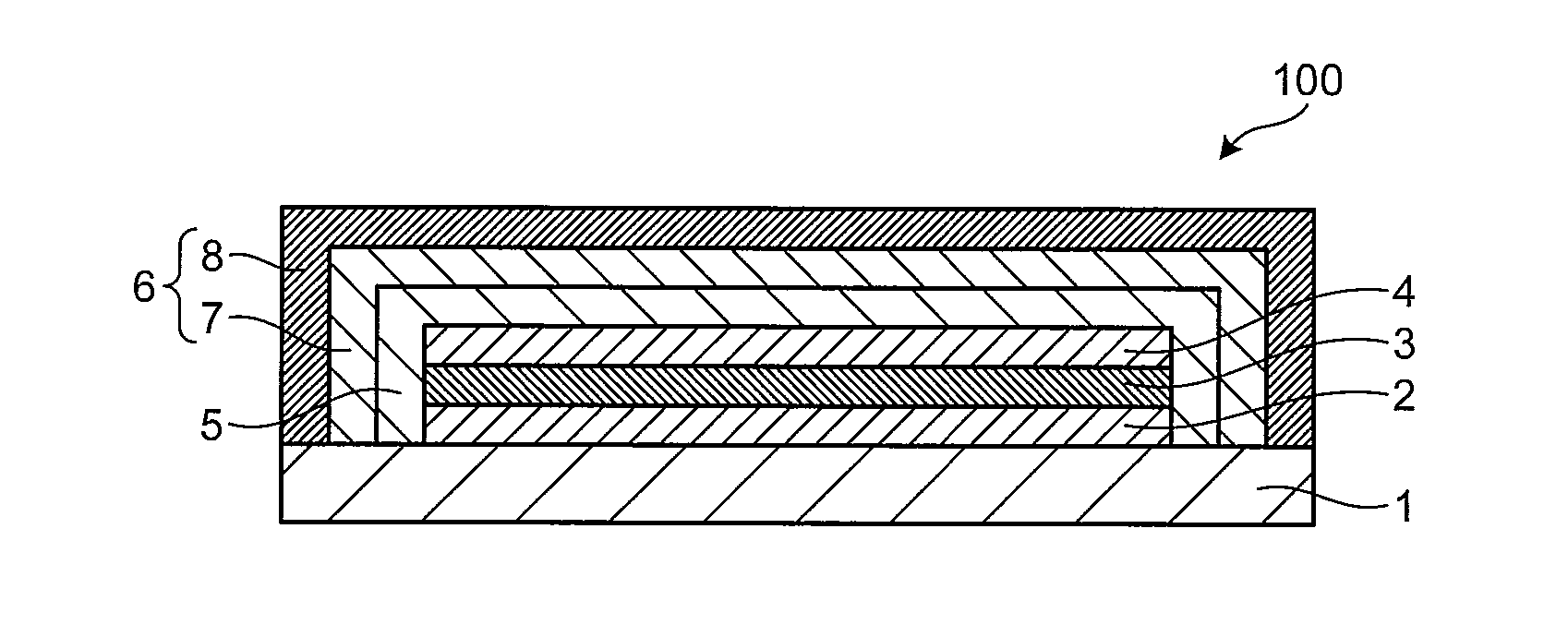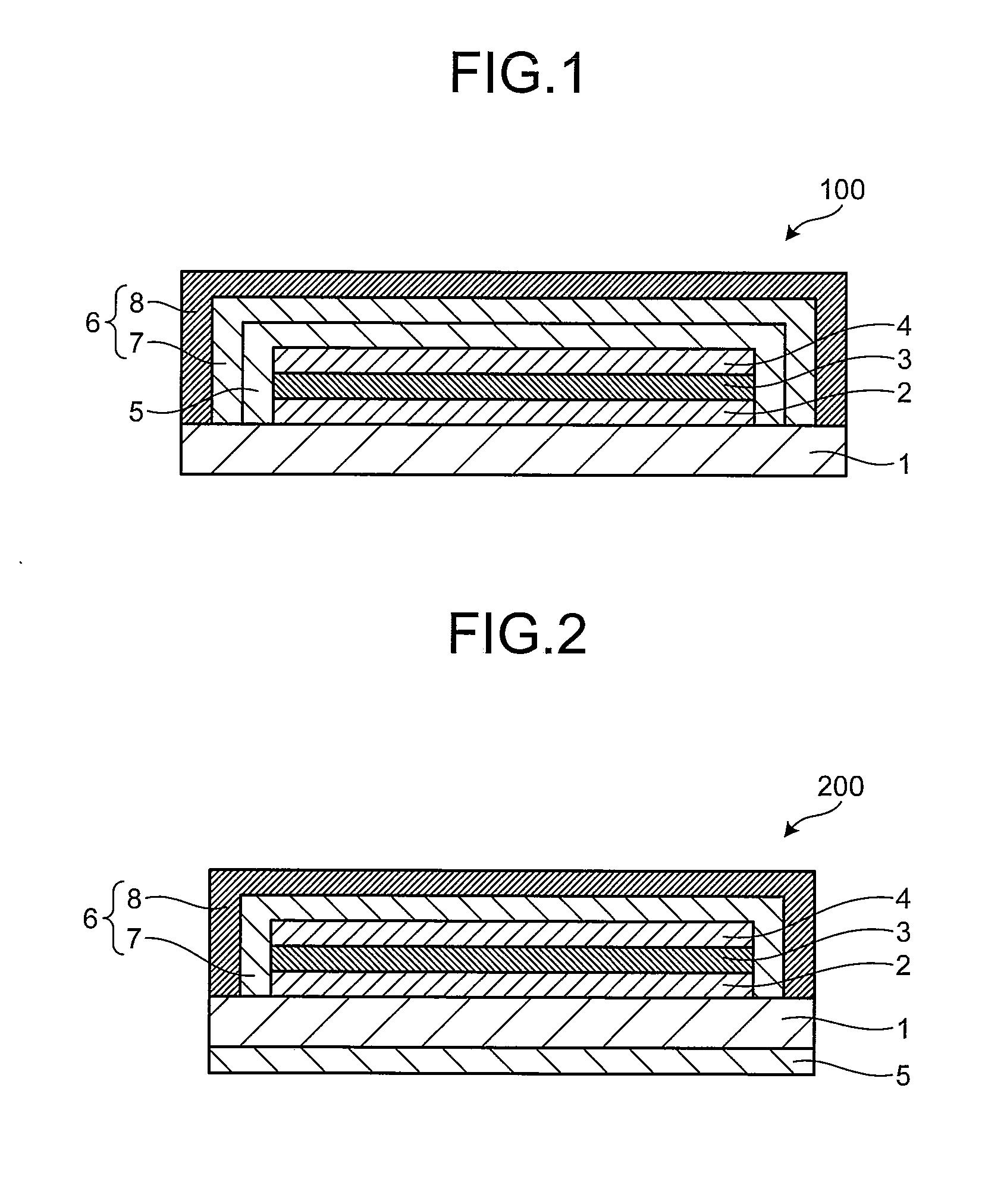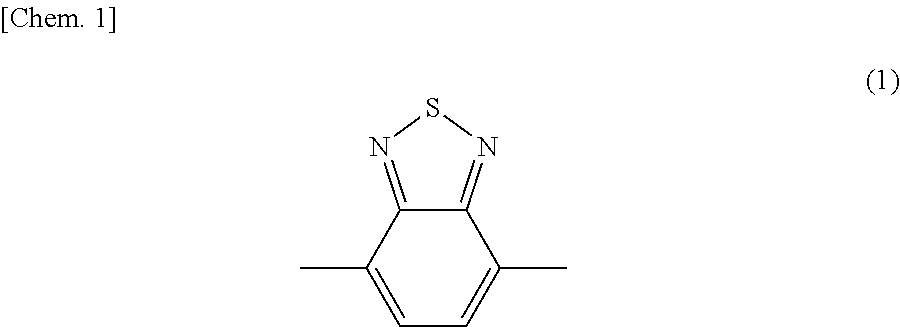Organic photovoltaic cell
- Summary
- Abstract
- Description
- Claims
- Application Information
AI Technical Summary
Benefits of technology
Problems solved by technology
Method used
Image
Examples
first embodiment
9-1. First Embodiment
[0139]An organic photovoltaic cell 100 illustrated in FIG. 1 comprises, on a substrate 1, a first electrode 2, an active layer 3 capable of generating a charge by incident light, and a second electrode 4 in this order. Each of the first electrode 2 and the second electrode 4 is connected with a terminal not illustrated in the schematic for extracting electricity to the exterior. On a surface of the organic photovoltaic cell 100, an ultraviolet absorbing layer 5 and a barrier layer 6 are provided in this order so as to cover the organic photovoltaic cell 100 except the substrate 1. Thus, the organic photovoltaic cell 100 comprises the substrate 1, the first electrode 2, the active layer 3, the second electrode 4, the ultraviolet absorbing layer 5, and the barrier layer 6 in this order.
[0140]The barrier layer 6 comprises an inorganic layer 7 comprising an inorganic material and an organic layer 8 formed from an organic material in this order from the active layer ...
second embodiment
9-2. Second Embodiment
[0145]An organic photovoltaic cell 200 illustrated in FIG. 2 has the same structure as that of the organic photovoltaic cell 100 of the first embodiment except that the ultraviolet absorbing layer 5 is placed on a undersurface of the substrate 1 on a position opposite to the active layer 3 of the first electrode 2. Thus, the organic photovoltaic cell 200 comprises the ultraviolet absorbing layer 5, the substrate 1, the first electrode 2, the active layer 3, the second electrode 4, and the barrier layer 6 in this order. The inorganic layer 7 and the organic layer 8 in the barrier layer are arranged in the order of the inorganic layer 7 and the organic layer 8 from the active layer 3. One or both of the inorganic layer 7 and the organic layer 8 comprise an ultraviolet absorber to be a layer having a function of blocking ultraviolet light.
[0146]The organic photovoltaic cell 200 has the structure as described above. Hence, when light is applied onto the organic pho...
example 1
[0164]A glass substrate patterned with an ITO film having a film thickness of about 150 nm as the first electrode by a sputtering method was prepared. The prepared glass substrate was washed with an organic solvent, an alkaline detergent, and ultrapure water, then dried, and subjected to ultraviolet light-ozone treatment (UV-O3 treatment) with an UV-O3 apparatus.
[0165]A suspension of poly(3,4-ethylenedioxythiophene) / poly(styrene sulfonate) (manufactured by H.C. Starck-V TECH Ltd., Bytron P TP AI 4083) was prepared and filtered with a filter having a pore size of 0.5 μm. The filtered suspension was applied onto a surface formed with the ITO film on the glass substrate by spin coating to form a film having a thickness of 70 nm. Then, the film was dried in the atmosphere on a hot plate at 200° C. for 10 minutes to form a functional layer.
[0166]Next, an ortho-dichlorobenzene solution comprising a macromolecular compound A being an alternating polymer that was obtained by copolymerizatio...
PUM
 Login to View More
Login to View More Abstract
Description
Claims
Application Information
 Login to View More
Login to View More - R&D
- Intellectual Property
- Life Sciences
- Materials
- Tech Scout
- Unparalleled Data Quality
- Higher Quality Content
- 60% Fewer Hallucinations
Browse by: Latest US Patents, China's latest patents, Technical Efficacy Thesaurus, Application Domain, Technology Topic, Popular Technical Reports.
© 2025 PatSnap. All rights reserved.Legal|Privacy policy|Modern Slavery Act Transparency Statement|Sitemap|About US| Contact US: help@patsnap.com



